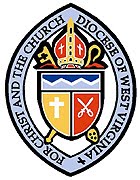Bishop of West Virginia
| Diocese of West Virginia | |
|---|---|
 |
|
| Location | |
| Ecclesiastical province | Province III |
| Statistics | |
| Congregations | 63 |
| Members | 8,103 (2016) |
| Information | |
| Rite | Episcopal |
| Current leadership | |
| Bishop | The Rt. Rev. W. Michie Klusmeyer Mark van Koevering (Assistant Bishop) |
| Map | |
 Location of the Diocese of West Virginia |
|
| Website | |
| www.wvdiocese.org | |
The Episcopal Diocese of West Virginia is a diocese of the Episcopal Church in the United States of America encompassing all 55 counties within the state of West Virginia. The Episcopal Diocese of West Virginia was formed from the Episcopal Diocese of Virginia, one of the nine original Dioceses of the Episcopal Church in the United States of America, by an act of the General Convention in 1877.
The first Episcopal Church in present-day West Virginia was established as a log structure that became known as Morgan Chapel near Bunker Hill in 1740 by Colonel Morgan Morgan. That chapel was occasionally served by a priest sent from Christ Church in Winchester, Virginia as well as by local lay readers. Although the church was disestablished in Virginia as the 19th century began, settlement continued in the region, particularly near the Ohio River.
Unlike most Virginia churches, due to the mountainous geography, churches in West Virginia were often planted by congregations from Pennsylvania, Maryland or Ohio. Thus, Bishop William White consecrated St. Matthew's Episcopal Church in Wheeling, West Virginia as the 19th century began. By 1851, Episcopalians in the northwestern mountain counties petitioned Virginia's bishop William Meade, who had founded St. John's Episcopal Church in Charleston, West Virginia in 1837, and serviced these parishes both while affiliated with Christ Church in Winchester and later as assistant bishop of Virginia, for their own bishop. Bishop Meade demurred, on account of the small number of parishes (7). When John Johns became his assistant bishop, he likewise conducted periodic visitations into the western counties. However, with the outbreak of the American Civil War, such visitations ceased. In 1863, shortly before West Virginia's incorporation as a state, St. Matthew's-Wheeling asked permission for another bishop to visit the parish, but like his predecessor, Bishop Johns demurred, asking instead for a safe-conduct to visit the area, which he did not obtain.
...
Wikipedia
